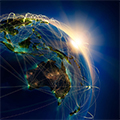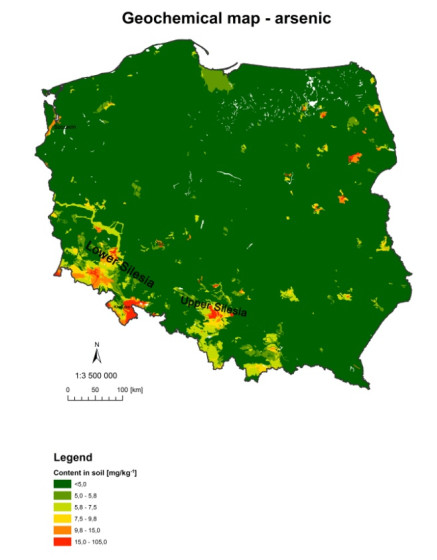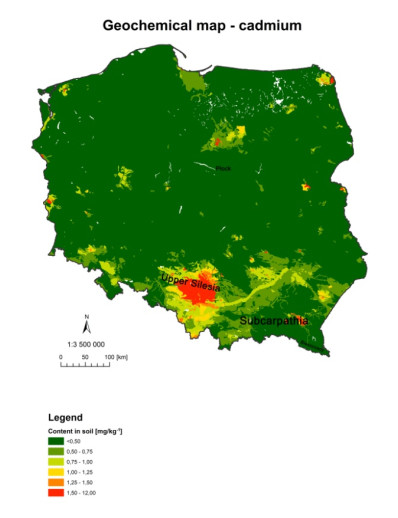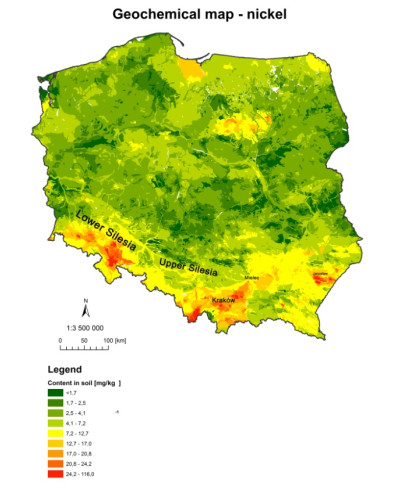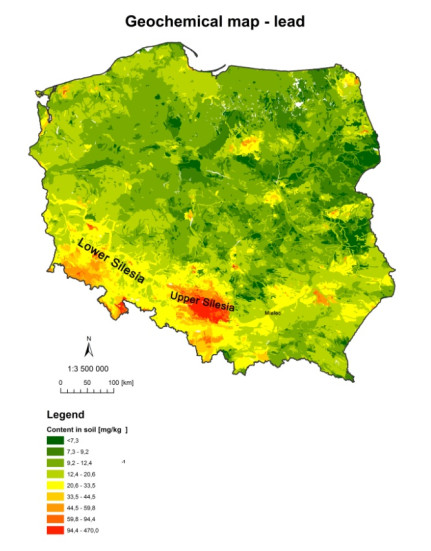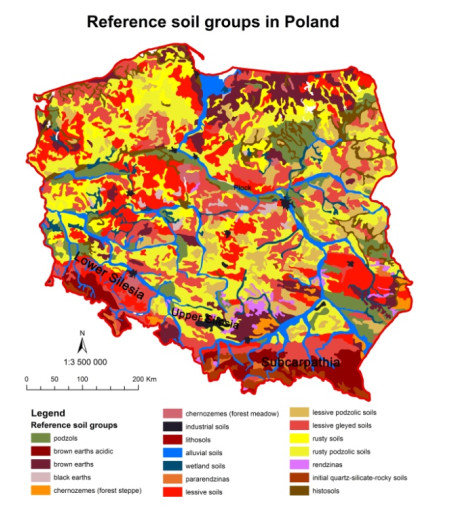The increasing number of spatial data sets permits their application for minimising the duration and cost of such research. An example of such application is geostatistical modelling. Data on the quality of atmospheric air can be used for the assessment of the quality of soil in a given area. The objective of the study was an attempt to apply geostatistical methods in the estimation of the degree of soil contamination with selected heavy metals resulting from deposition from atmospheric air. This paper uses data obtained from the State Environmental Monitoring (data on the quality of atmospheric air) and other collections of publicly available spatial data for the purpose of analysis of the state of quality of soils in the province of Silesia in Poland. Conducted analyses revealing that contamination with lead in atmospheric air in the Silesian voivodeship considerably exceeds acceptable values, and the load of lead deposition is largely transferred to the soil. The paper also presents geochemical maps necessary to understand sources of soil contamination, including their natural content.
1.
Introduction
Special functions play essential parts in the applied sciences. Quantum mechanics, numerical analysis, and approximation theory are just a few of the many fields where special functions make an appearance, making them extremely important; see, for example, [1,2,3]. Many researchers have performed investigations regarding the different types of special functions. For example, the authors of [4,5,6] have studied some degenerate polynomials. Some other sequences of polynomials were investigated in [7,8].
Orthogonal polynomials are more widely used in approximation theory than non-orthogonal polynomials. The classical orthogonal polynomials, including Jacobi, Hermite, and Laguerre polynomials, have essential roles in solving different types of differential equations (DEs); see, for example, [9,10,11,12]. In addition, there are theoretical results concerned with the classical orthogonal polynomials; see, for example, [13,14]. Several authors also addressed the non-orthogonal polynomials from both a theoretical and practical perspective; see, for instance, [15,16,17,18,19,20].
Chebyshev polynomials (CPs) play essential roles in a wide variety of fields. A trigonometric expression may be found for each of these polynomials. The recurrence formula is the same for all four kinds of CPs, even though their initials differ. They are particular ones of the classical Jacobi polynomials (JPs). All four kinds were extensively utilized in various problems in numerical analysis. For some contributions that employ these polynomials, one can be referred to [21,22,23,24,25,26,27]. Some modified CPs were constructed to incorporate some initial and boundary conditions imposed on the given DEs. For example, in [28], the authors introduced new modified second-kind CPs and utilized them to treat third-order Emden-Fowler singular DEs.
Several articles explore various generalizations of different polynomials and CPs in particular. The authors in [29] have utilized generalized shifted CPs for a class of fractional DEs. The authors in [30] studied some generalized CPs. Another type of generalized CPs of the second kind was investigated in [31]. A novel class of generalized CPs of the first kind was presented by the authors of [32]. In addition, they employed these polynomials in conjunction with the Galerkin method to treat multi-term fractional DEs. A type of generalized CPs was theoretically studied in [33]. For other studies on generalized polynomials, one can read [34,35,36,37].
Several particular polynomial formulae are very useful in numerical analysis and approximation theory. For example, the derivative expressions of given polynomials as combinations of their original ones are helpful to obtain spectral solutions of various DEs. For example, the authors in [38] used the derivatives of the generalized third-kind CPs to obtain solutions of even-order DEs. In contrast, the derivatives of the sixth-kind CPs were utilized in [39] to solve a type of Burger's DE. In addition, the operational matrix of derivatives can be constructed from the first-order derivative of a given set of polynomials. This matrix is the core of many approaches to solving different types of DEs; see, for example, [40,41]. Formulas for connecting and linearizing different polynomials are also of significance. Some nonlinear DEs may be effectively treated using the linearization formulae; see, for example, [42]. Several efforts were dedicated to deriving these formulae; see, for example, [43,44,45,46].
Hypergeometric functions (HGFs) are essential tools in studying special functions. They provide an expression for nearly all of the well-known functions and polynomials. New formulas for various special functions can be obtained by performing transformations between HGFs (see, for example, [44]). It is worthy of mentioning here also that the coefficients of the expressions related to the derivatives, integrals, moments, connection, and linearization formulas are often expressed in terms of HGFs of different arguments (see, for example, [47,48,49,50]).
The primary objective of this work is to present a class of generalized CPs. The classical JPs are known to include all four types of CPs. In this paper, the introduced generalized sequence differs from the class of classical JPs. Some fundamental formulas of these polynomials are first introduced, and after that, they are utilized to derive other important problems related to special functions, such as connection and linearization problems. In addition, some definite integrals and weighted definite integrals are computed based on some introduced formulas. According to our knowledge, the paper contains many new formulas and a novel approach.
The current article is structured as follows: Section 2 presents some basic formulas of the UCPs and some orthogonal and non-orthogonal polynomials. The main objective of Section 3 is to obtain novel formulas for the derivatives of the UCPs by using combinations of orthogonal and non-orthogonal polynomials. Section 4 aims to develop the inverse formulae to those provided in Section 3. Section 5 presents some linearization formulas for the UCPs. An application to evaluate some new definite integrals based on the application to the derived formulas is given in Section 6. We end the paper with some discussion and suggest some expected future work in Section 7.
2.
Some fundamental properties of the UCPs and other well-known polynomials
This section presents some basic characteristics and relations related to the UCPs. Furthermore, an account of some particular polynomials is provided.
2.1. Some basic formulas concerned with the UCPs
Consider the UCPs that can be generated by using the following recursive formula:
It is clear that the polynomial solution of (2.1) GA,B,Ri(x) is a polynomial that generalizes all the well-known four kinds of CPs. The following identities hold:
where Ti(x),Ui(x),Vi(x) and Wi(x) are respectively the well-known four kinds of CPs.
Remark 2.1. Although the four kinds of CPs are special cases of GA,B,Ri(x) as seen from (2.2) and (2.3), they are also special ones of the JPs, but the class of polynomials GA,B,Ri(x) is another generalized class that differs from the JPs class.
Remark 2.2. The analytic formula and its inversion formula are widely recognized as fundamental tools for the theoretical investigation of any collection of polynomials. The following section will provide the derivation of the fundamental formulae for GA,B,Ri(x).
Now, we will prove a significant theorem, in which we show that GA,B,Ri(x) can be represented as a combination of three consecutive terms of the second-kind CPs.
Theorem 2.1. For all j≥0, we have
Proof. First, assume the polynomial:
Noting that U−2(x)=−1, U−1(x)=0. Obviously, θ0(x)=A, θ1(x)=Bx+R. This shows that θ0(x)=GA,B,R0(x) and θ1(x)=GA,B,R1(x). So, to prove that θj(x)=GA,B,Rj(x), ∀ j≥2, it is sufficient to show that they satisfy the same recurrence relation. So, we are going to show the satisfaction of the following recurrence relation for all j≥0
Now, we have
If we substitute by the recurrence relation of Uj(x) written in the form
in the right-hand side of (2.7), then it is not difficult to show that
Theorem 2.1 is now proved. □
Now, based on the above theorem, an explicit analytic formula of GA,B,Ri(x) can be deduced.
Theorem 2.2. For every positive number i, the following analytic formula holds:
Proof. Based on the expression in (2.4) along with the explicit expression of Uj(x) given by
Formula (2.10) can be obtained. □
The theorems presented next provide the formulae for calculating the moments and inversion of the polynomials GA,B,Ri(x).
Theorem 2.3. For all non-negative integers (NNIs) i and m, the following moment formula holds
Proof. Easy by applying induction on m based on the recurrence relation (2.1). □
Corollary 2.1. The next formula applies to every non-negative integer (NNI) m.
Proof. Direct by setting i=0 in Formula (2.11). □
It is useful to introduce the shifted polynomials for GA,B,Rj(x) defined as
The recurrence relation that these polynomials fulfill is
Now, we give the counterparts results for Theorem 2.3 and Corollary 2.1 for the shifted polynomials ˜GA,B,Rj.
Theorem 2.4. The following moment formula applies for all NNIs r and n
Proof. We can proceed with the proof by induction based on the recurrence relation (2.13). □
Corollary 2.2. The inversion formula of ˜GA,B,Rj(x) for every NNI r is shown below
Proof. This formula is a direct special case of Formula (2.14) setting n=0. □
2.2. An overview on well-known polynomials: both symmetric and nonsymmetric
An introduction to symmetric and nonsymmetric polynomials, both orthogonal and non-orthogonal, is provided in this section.
Let ϕj(x) and ψj(x) represent, respectively, two sets of symmetric and nonsymmetric polynomials that have the following expressions:
where Ar,j and Br,j are known coefficients.
Assume also that the inverse formulas to (2.16) and (2.17) can be written as
with the known coefficients ˉAr,j and ˉBr,j.
Among the nonsymmetric polynomials is the general class of the classical JPs, which includes some symmetric classes. The JPs have the following hypergeometric expression:
The shifted JPs on [0,1] can be defined as
The ultraspherical polynomials are defined as
For a survey on the classical orthogonal polynomials, one can consult [51,52].
Now, we give two classes of non-orthogonal polynomials: generalized Fibonacci and generalized Lucas polynomials. Fa,br(x) and Lc,dr(x) that were studied [53] can be constructed respectively as
Remark 2.3. Important formulas concerning certain polynomials can be derived from their power form representation and associated inversion formula. The four formulas in (2.16)–(2.19) are expressions for the analytic forms and their inversion ones for symmetric and nonsymmetric polynomials. It is clear that these formulas are known if the coefficients Ar,j, Br,j, ˉAr,j, and ˉBr,j are determined. In the following table, we give these coefficients for a group of celebrated polynomials that we will use in this paper. The coefficients for the shifted Jacobi polynomials (SJPs), ultraspherical polynomials (UPs), generalized Laguerre polynomials (LGPs), Hermite polynomials (HPs), generalized Fibonacci polynomials (GFPs), generalized Lucas polynomials (GLuPs), and Bernoulli polynomials (BPs) will be listed in Table 1.
Note that Br in the last row of the table represents the well-known Bernoulli polynomials, where ξr in the column before the last one is defined as
3.
Some formulas for the derivatives of the UCPs
This section aims to develop new derivative formulas of the UCPs using various other polynomials. The formulae relating the UCPs to other polynomials may be obtained as special cases. More specifically, we'll establish the following expressions:
● The derivatives' expressions of the UCPs in terms of other parameters' UCPs.
● The derivatives expressions of UCPs in terms of some other orthogonal and non-orthogonal polynomials.
3.1. Derivatives of UCPs in terms of other UCPs
We consider the two different UCPs GA,B,Ri(x) and GˉA,ˉB,ˉRi(x). For convenience, we will denote Gi(x)=GA,B,Ri(x) and ˉGi(x)=GˉA,ˉB,ˉRi(x). We will derive a novel expression that relates the derivatives of Gi(x) to ˉGi(x). To begin, it is necessary to establish the following lemma.
Lemma 3.1. Consider a NNI v. We have
Proof. If we let
then based on Zeilberger's algorithm ([54]), it is possible to show that Zv,j,s fulfills the following recursive formula
with the initial value: Z0,j,s=1. This first-order recursive formula can be solved quickly to produce
This proves the lemma. □
Theorem 3.1. Consider the NNIs j and s with j≥s≥1. We have
Proof. From the analytic form in (2.10), it is not difficult to express DsGj(x) in the form
Utilizing the inversion formula (2.12), we are able to get the expression
Following several algebraic calculations, the preceding formula may be written in the following way:
Now, to obtain a more simplified formula of (3.5), we make use of the transformation formula:
and accordingly, the Chu-Vandermonde identity ([51]) can be used to get
Thanks to (3.7) along with Lemma 3.1, Formula (3.5) is transformed into the following simplified one:
This proves Theorem 3.1. □
Remark 3.1. Since Formula (3.2) expresses the derivatives formula of Gj(x) in terms of ˉGj(x), so many special formulas can be deduced taking into consideration the four special cases in (2.2) and (2.3). We will now demonstrate these results.
Corollary 3.1. For all j≥s≥1, the following expressions hold
3.2. Derivatives with some other symmetric and nonsymmetric polynomials
This section is interested in deriving some other derivative expressions of the UCPs but in terms of various symmetric and nonsymmetric polynomials. Some of these polynomials are orthogonal, and some others are non-orthogonal.
Theorem 3.2. Consider the NNIs j and s with j≥s, We have the following derivative expressions as combinations of U(ζ)j(x)
Proof. Starting from the expression of DsGj(x) along with the inversion formula of the ultraspherical polynomials leads to the following formula:
The above relation can be set in the following form
Zeilberger's algorithm aids in finding the following closed forms:
and therefore, Formula (3.12) can be obtained. □
Corollary 3.2. The UCPs-ultraspherical connection formula is
Proof. Formula (3.17) is a specific formula of (3.12) for s=0. □
Remark 3.2. Since Legendre polynomials and CPs of the first and second kinds are particular ones of special cases of U(ζ)j(x), we may infer certain particular formulae from (3.12). The following corollaries display the results.
Corollary 3.3. Let j≥s≥1. We have the following formula:
In particular, we have:
Proof. Setting ζ=0 in (3.12) and (3.17) yields respectively (3.18) and (3.19). □
Corollary 3.4. Let j≥s≥1. We have the following formula:
and in particular:
Proof. Setting ζ=0 in (3.12) and (3.17) yields respectively (3.20) and (3.21). □
Corollary 3.5. Let j≥s≥1. We have the following formula:
and in particular:
Proof. Setting ζ=12 in (3.12) and (3.17) yields respectively (3.22) and (3.23). □
Remark 3.3. Similar steps to those followed to prove Theorem 3.2 can be used to obtain derivative expressions for UCPs in terms of other symmetric polynomials. The results of Table 1 are used to derive the desired formulas. The following four theorems exhibit some derivative expressions.
Theorem 3.3. Consider the NNIs j and s with j≥s. We have
Theorem 3.4. Consider the NNIs j and s with j≥s. One has the following derivative expressions:
Theorem 3.5. Consider the NNIs j and s with j≥s. We have
Remark 3.4. Other expressions of DsGj(x) in terms of nonsymmetric polynomials are expressed as in (2.17). For example, in the following, we give with proof an expression for DsGj(x) in terms of Bernoulli polynomials.
Theorem 3.6. Consider the NNIs j and s with j≥s. We have
where
Proof. It is possible to express DsGj(x) as a result of (2.10).
with
The formula for the inversion of Bernoulli polynomials (see, the last column of Table 1) enables one to get
where
This formula results from extensive manipulations
The last formula is equivalent to
Symbolic computation, and in particular Zeilberger's algorithm [54], helps to find the three simple forms for the internal sums that appear in (3.31).
Substituting the last three summations from Eqs (3.32)–(3.34) into Formula (3.31), we can derive Formula (3.27). Consequently, Theorem 3.6 is proved. □
4.
Derivatives' expressions of various celebrated polynomials in terms of UCPs
This section deals with polynomial expressions based on UCPs. Connection formulas between different polynomials with the UCPs can be deduced as special cases.
Theorem 4.1. Consider the NNIs j,s with j≥s. The following expression holds:
Proof. The formula (4.1) can be obtained using the analytic form of U(ζ)j(x) (Table 1, the second column) along with the inversion formula (2.12). □
Theorem 4.2. Consider the NNIs j,s with j≥s. The following expression holds:
where the notation pFq(z) is the regularized hypergeometric function, see [44].
Proof. The analytic form of Hj(x) can be used in conjunction with the inversion formula (2.12) to produce (4.2). □
Theorem 4.3. Consider the NNIs j,s with j≥s. The following expression holds:
Proof. The series expression of Fa,bj(x) can be used in conjunction with the inversion formula (2.12) to produce (4.3). □
Theorem 4.4. Consider the NNIs j,s with j≥s. The following expression holds:
Proof. The series expression of Lc,dj(x) can be used in conjunction with the inversion formula (2.12) to produce (4.4). □
Theorem 4.5. Consider the NNIs j,s with j≥s. The following expression holds:
Proof. The analytic form of ˜P(ρ,μ)j(x) yields the following formula
We utilize the inversion formula of ˜Gi(x), consequently, the next equation can be deduced:
Alternatively, it may be expressed as:
Accordingly, the last formula can be written in a hypergeometric form as follows:
Replacing x by 1+x2 in (4.8), Formula (4.5) can be obtained. □
Corollary 4.1. Let j≥s. For μ=ρ+1, Formula (4.5) reduces to the following formula
Proof. Setting μ=ρ+1 in (4.5) yields
Zeibreger's algorithm ([54]) can aid us to sum the 3F2(1) that appears in the last formula. Setting
then Mv,j,s meets the next recursive formula
accompanied by the initial conditions
that can be solved to give
and therefore, Formula (4.10) can be obtained. □
5.
Linearization formulas of the UCPs
In this section, we will develop a new linearization formula (LF) for the UCPs based on these polynomials' analytic form and moments formula. Furthermore, some other linearization formulas for UCPs with some other polynomials will also be derived. More precisely, the following linearization problems will be solved:
for certain polynomials ϕj(x).
5.1. Linearization formula of the UCPs
The following theorem exhibits the LF of Gi(x). This formula generalizes some well-known formulas.
Theorem 5.1. Consider the two NNIs i and j. The following LF applies:
Proof. The analytic form in (2.10) leads to obtaining the following formula
As a result of the moment formula (2.11), we obtain the following formula
The following formula can be derived from a series of computations:
Considering these two identities:
the next simplified LF be acquired:
This finalizes the proof of Theorem 5.1. □
Remark 5.1. Some well-known LFs can be extracted from the LF (5.4). The following corollary exhibits these formulas.
Corollary 5.1. Consider two NNIs. The following LFs hold:
Proof. Formulas (5.10)–(5.13) can be easily obtained as special cases of (5.4) noting the specific classes in (2.2) and (2.3). □
5.2. LFs of the UCPs with some symmetric polynomials
This part is interested in developing other product formulas of the UCPs with some other polynomials.
Theorem 5.2. Consider the two NNIs i and j. The following LF holds
Proof. Starting with the analytic form of Fa,bi(x), we can write
Making use of the moment formula (2.11), we get
which can be written as
which is also equivalent to
This finalizes the proof of Theorem 5.2. □
Theorem 5.3. Consider the two NNIs i and j. The following LF holds:
Proof. Similar to the proof of Theorem 5.2. □
Theorem 5.4. Consider the two NNIs i and j. The following LF holds
Proof. Just like the proof of Theorem 5.2. □
Theorem 5.5. Consider the two NNIs i and j. The following LF holds
where U(c,d,y) denotes the confluent hypergeometric function (see, [51]).
Proof. Similar to the proof of Theorem 5.2. □
5.3. LFs of the UCPs with some nonsymmetric polynomials
Here, we give some LFs of the UCPs with some nonsymmetric polynomials. The product formulas with the shifted Jacobi and generalized Lageurre polynomials will be developed.
Theorem 5.6. Consider the two NNIs i and j. The following LF holds
Proof. The analytic form of the shifted JPs (presented in Table 1) allows one to write the following formula:
which turns into
After a series of algebraic computations, (5.24) converts into the following one
In virtue of the two identities:
Formula (5.25) can be written as in (5.22). □
Remark 5.2. The two terminating 4F3(1) can be reduced for some negative choices of ρ and μ. The following corollaries exhibit some of these results: It is worth mentioning here that some authors investigated the class of JPs whose parameters are certain negative integers (see, [55,56]).
Corollary 5.2. Consider the two NNIs i and j. We have
Proof. If we substitute ρ=−i into Formula (5.22), it yields
Chu-Vandemomne identity leads to the following two identities:
and hence, Formula (5.29) reduces to Formula (5.28). □
Remark 5.3. Some other special reduced formulas of the general formula in (5.22) can be also deduced. The details are omitted.
Corollary 5.3. Consider the two NNIs i and j. We have
Corollary 5.4. Consider the two NNIs i and j. We have
Corollary 5.5. Consider the two NNIs i and j. We have
6.
Closed forms for some integrals and weighted integrals
This section presents new integral and weighted integral formulas based on applying some of the introduced formulas derived in the previous sections.
6.1. Some definite integrals of products involving the UCPs
Corollary 6.1. For every j≥2, the following identity holds
Proof. In virtue of Formula (2.4), we can write
But, since the following integral holds for Uj(x) (see, [15])
So it is easy to conclude Formula (6.1). □
Corollary 6.2. For every i and j greater than or equal to 2, the following identity holds
where Sj is given as in (6.1).
Proof. The integral formula can be achieved by using LF (5.4) along with the integral formula (6.1). □
6.2. Some weighted integrals of products involving the UCPs
Some weighted integral formulas can be computed based on the derivative expressions of the UCPs and connection formulas with some orthogonal polynomials. Here are some of these results.
Corollary 6.3. For every j≥s, the following identity holds
Proof. Formula (3.24) leads to the following integral formula:
where
The orthogonality relation of Hermite polynomials ([57]) helps to put (6.4) as
where δi,j is the well-known Kronecker delta functions and hm is given by
Simple computations lead to (6.3). □
Corollary 6.4. For all NNIs j and m, the following identity holds:
Proof. A direct special case of Formula (6.3) for s=0. □
Corollary 6.5. For every j≥s, the following identity holds
Proof. Starting with Formula (3.12) and applying the orthogonality relation of the ultraspherical polynomials [58], we may derive Formula (6.7). □
Corollary 6.6. For every j, the following identity holds
Proof. Direct from (6.7) setting s=0. □
7.
Conclusions
This research opened new horizons for studying new types of polynomials that satisfy the same recurrence relation of CPs but with general initials. Thus, the solution of this recurrence relation produced generalized polynomials that all four kinds of CPs are special ones of them. We proved an important result for the generalized polynomials: They can be expressed as three terms of consecutive terms of the second kind of CPs. This result enabled us to derive some other fundamental formulas for generalized polynomials. Expressions for the derivatives of these polynomials are given in terms of some other symmetric and nonsymmetric polynomials. Some connection formulas can also be deduced. The LF of the generalized polynomials and some triple product formulas were also deduced. In future work, we aim to investigate other generalized sequences of polynomials and establish some important formulas concerned with them.
Author contributions
Waleed Mohamed Abd-Elhameed: Conceptualization, Methodology, Validation, Formal analysis, Funding acquisition, Investigation, Project administration, Supervision, Writing-Original draft, Writing-review & editing; Omar Mazen Alqubori: Validation, Investigation. All authors have read and approved the final version of the manuscript for publication.
Use of AI tools declaration
The authors declare that they have not used artificial intelligence tools in the creation of this article.
Acknowledgement
This work was funded by the University of Jeddah, Jeddah, Saudi Arabia, under grant No. (UJ-23-DR-254). Therefore, the authors thank the University of Jeddah for its technical and financial support.
Conflict of interest
The authors declare that they have no competing interests.









 DownLoad:
DownLoad:

